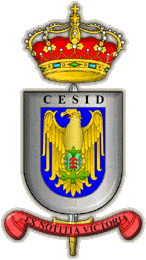Cesid
(Intelligence agency) | |
|---|---|
 | |
| Successor | Centro Nacional de Inteligencia |
| Formation | July 14, 1977 |
| Founder | Manuel Gutiérrez Mellado |
| Extinction | 2002 |
| Headquarters | Madrid, Spain |
| Leader | Emilio Alonso Manglano |
| Staff | 2,580 |
| Spanish intelligence agency closely tied to the PSOE government of Felipe González. | |
The Centro Superior de Información de la Defensa (English: Superior Center of Defense Information; CESID) was the Spanish intelligence agency before the current Centro Nacional de Inteligencia (CNI) took over as its successor in 2002. Like its Francoist direct predecessor, it was also responsible for the Spanish part of Gladio during its existence.
It is unclear to what extent Minister of Defence Narcis Serra and Prime Minister Felipe Gonzalez were part of the system, or what parts they were kept out of, but they too used Cesid for surveillance purposes.[1]
History
The Centro Superior de Información de la Defensa was established in 1977 by Defense Minister Manuel Gutiérrez Mellado to replace the discredited former Francoist intelligence services (notably SECED and the military Segunda Bis) in order to prepare Spain for a more democratic rule[2] Its first Director, General Jose Maria Burgon Lopez-Doriga, saw to it that it was made up mostly by ex-members of the SECED.[3]
By a royal decree of January 1984, CESID was defined legally as the intelligence agency of the prime minister. Nevertheless, it was fundamentally military in nature, and its head from 1981 was an army lieutenant general, Emilio Alonso Manglano, "one of the best informed men in Spain"[4], who sat until 1995.[5][6]
Manglano was appointed by Prime Minister Leopoldo Calvo Sotelo after the attempted 23-F coup d'état, and subsequently ratified by the PSOE.[6] Manglano was his agency's liaison to Nato's security office, likely as part of Gladio.[7]
Employing about 2,000 individuals as of 1988, CESID was staffed primarily by the military, supplemented by 500 members of the Civil Guard and by 80 plainclothes police. About 30 percent of the members of the staff were civilians, said to be selected usually from among close relatives of military officers. Women had been confined largely to administrative tasks, but they were increasingly being entrusted with operational assignments.
The principal operating units were domestic intelligence; foreign intelligence; counterintelligence; economics and technology (primarily industrial espionage); and operational support (principally application of bugs for surveillance and eavesdropping).
Illegal eavesdropping
Manglano submitted his resignation in 1995 due to the scandal of the so-called 'Cesid eavesdropping', where hundreds of communications were illegally recorded between 1983 and 1991 to politicians, businessmen, journalists and even King Juan Carlos himself.
Manglano was aware of all the reports of state issues such as ETA terrorism, corruption of the socialist government or the attempt to overthrow Felipe González. [8]
Manglano appealed the sentence of six months of arrest and eight years of disqualification for this bugging,[9] and was finally exonerated when the charges against him were dropped.[4]
Gladio
Former Spanish army colonel Amadeo Martinez Ingles stated that the secret espionage network Gladio" had in Spain "an intelligence service very well prepared to investigate politicians of an 'aperturista' or democratic character" during the Franco period. Martinez Ingles maintained as well that Gladio played a very significant role during the last years of the Franco regime, and that, after that period, the infrastructure of the anticommunist network, known as 'parallel Nato', 'passed over to Cesid and the intelligence services of post-Francoist democracy.[7]
References
- ↑ https://www.abc.es/espana/abci-conde-narcis-serra-espiaba-todo-mundo-incluido-202110131058_noticia.html
- ↑ Paul Preston (2005); The Triumph of Democracy in Spain, p. 97
- ↑ https://ia600906.us.archive.org/4/items/pdfy-_UhNJeq7Rz2kfgOI/Ganser%20-%20NATO%27s%20Secret%20Armies%20-%20Operation%20Gladio%20and%20Terrorism%20in%20Western%20Europe%20%282005%29.pdf
- ↑ Jump up to: a b https://elcierredigital.com/investigacion/584839637/historia-emilio-alonso-manglano-servicios-secretos-transicion-llegado-aznar.html
- ↑ Ruiz Miguel, Carlos.: El CESID: Historia de un intento de modernización de los Servidos de Inteligencia Arbor CLXXX, 709 (January 2005), pp. 121–150
- ↑ Jump up to: a b https://www.elmundo.es/elmundo/2013/07/08/espana/1373280878.html
- ↑ Jump up to: a b https://documents.theblackvault.com/documents/coldwarera/gladio-statedept.pdf
- ↑ https://www.abc.es/espana/abci-que-son-papeles-manglano-nsv-202110051711_noticia.html
- ↑ https://www.elmundo.es/elmundo/1999/mayo/27/nacional/fallo.html